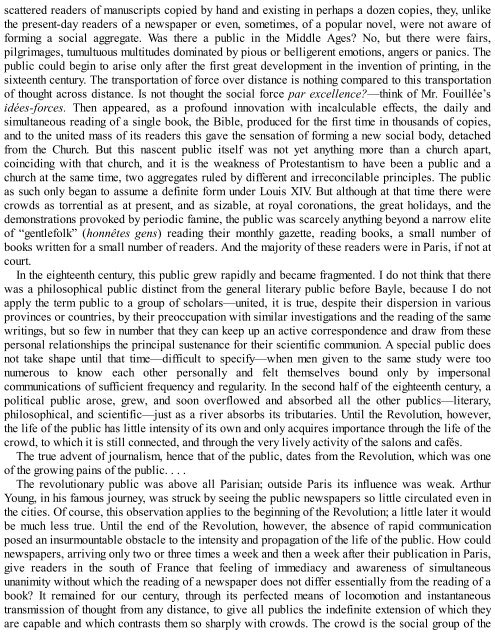3658925934
Create successful ePaper yourself
Turn your PDF publications into a flip-book with our unique Google optimized e-Paper software.
scattered readers of manuscripts copied by hand and existing in perhaps a dozen copies, they, unlike<br />
the present-day readers of a newspaper or even, sometimes, of a popular novel, were not aware of<br />
forming a social aggregate. Was there a public in the Middle Ages? No, but there were fairs,<br />
pilgrimages, tumultuous multitudes dominated by pious or belligerent emotions, angers or panics. The<br />
public could begin to arise only after the first great development in the invention of printing, in the<br />
sixteenth century. The transportation of force over distance is nothing compared to this transportation<br />
of thought across distance. Is not thought the social force par excellence?—think of Mr. Fouillée’s<br />
idées-forces. Then appeared, as a profound innovation with incalculable effects, the daily and<br />
simultaneous reading of a single book, the Bible, produced for the first time in thousands of copies,<br />
and to the united mass of its readers this gave the sensation of forming a new social body, detached<br />
from the Church. But this nascent public itself was not yet anything more than a church apart,<br />
coinciding with that church, and it is the weakness of Protestantism to have been a public and a<br />
church at the same time, two aggregates ruled by different and irreconcilable principles. The public<br />
as such only began to assume a definite form under Louis XIV. But although at that time there were<br />
crowds as torrential as at present, and as sizable, at royal coronations, the great holidays, and the<br />
demonstrations provoked by periodic famine, the public was scarcely anything beyond a narrow elite<br />
of “gentlefolk” (honnêtes gens) reading their monthly gazette, reading books, a small number of<br />
books written for a small number of readers. And the majority of these readers were in Paris, if not at<br />
court.<br />
In the eighteenth century, this public grew rapidly and became fragmented. I do not think that there<br />
was a philosophical public distinct from the general literary public before Bayle, because I do not<br />
apply the term public to a group of scholars—united, it is true, despite their dispersion in various<br />
provinces or countries, by their preoccupation with similar investigations and the reading of the same<br />
writings, but so few in number that they can keep up an active correspondence and draw from these<br />
personal relationships the principal sustenance for their scientific communion. A special public does<br />
not take shape until that time—difficult to specify—when men given to the same study were too<br />
numerous to know each other personally and felt themselves bound only by impersonal<br />
communications of sufficient frequency and regularity. In the second half of the eighteenth century, a<br />
political public arose, grew, and soon overflowed and absorbed all the other publics—literary,<br />
philosophical, and scientific—just as a river absorbs its tributaries. Until the Revolution, however,<br />
the life of the public has little intensity of its own and only acquires importance through the life of the<br />
crowd, to which it is still connected, and through the very lively activity of the salons and cafés.<br />
The true advent of journalism, hence that of the public, dates from the Revolution, which was one<br />
of the growing pains of the public. . . .<br />
The revolutionary public was above all Parisian; outside Paris its influence was weak. Arthur<br />
Young, in his famous journey, was struck by seeing the public newspapers so little circulated even in<br />
the cities. Of course, this observation applies to the beginning of the Revolution; a little later it would<br />
be much less true. Until the end of the Revolution, however, the absence of rapid communication<br />
posed an insurmountable obstacle to the intensity and propagation of the life of the public. How could<br />
newspapers, arriving only two or three times a week and then a week after their publication in Paris,<br />
give readers in the south of France that feeling of immediacy and awareness of simultaneous<br />
unanimity without which the reading of a newspaper does not differ essentially from the reading of a<br />
book? It remained for our century, through its perfected means of locomotion and instantaneous<br />
transmission of thought from any distance, to give all publics the indefinite extension of which they<br />
are capable and which contrasts them so sharply with crowds. The crowd is the social group of the









![Genki - An Integrated Course in Elementary Japanese II [Second Edition] (2011), WITH PDF BOOKMARKS!](https://img.yumpu.com/58322134/1/180x260/genki-an-integrated-course-in-elementary-japanese-ii-second-edition-2011-with-pdf-bookmarks.jpg?quality=85)
![Genki - An Integrated Course in Elementary Japanese I [Second Edition] (2011), WITH PDF BOOKMARKS!](https://img.yumpu.com/58322120/1/182x260/genki-an-integrated-course-in-elementary-japanese-i-second-edition-2011-with-pdf-bookmarks.jpg?quality=85)





